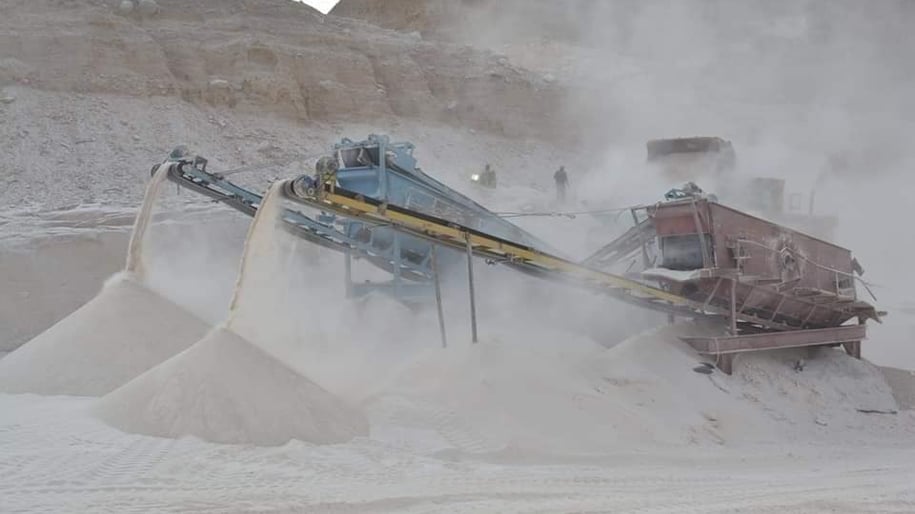silica sand
Zain international for Mining & Export Company is a global leader in the production and export of silica sand with global quality and the best price for more than 10 years. Egypt is a country rich in the best types of minerals. The most famous silica sand mines are located in Zafarana in the Red Sea and Abu Zenim in South Sinai. White silica sand is used in the field of manufacturing all types of glass, fiberglass, ceramics, porcelain, and others. El Nasr Company owns different mines for all types of silica sand and uses modern equipment to maintain the purity of the sand and the best transportation fleet and contracts with shipping lines for the ease and speed of transporting sand inside and outside Egypt. Silica sand is one of the most abundant and diverse natural materials in the world. Composed primarily of silicon dioxide (SiO2), it is usually found in the form of pure quartz. This sand originated over long geological periods of fragmentation and transport by wind and water, resulting in its concentration in specific areas. Silica sand is a raw material in many modern industries and is widely used in the manufacture of glass, electronics, and building materials. Silica sand is characterized by its high purity and high heat resistance, making it a preferred material for applications requiring chemical and thermal stability. Its superior physical properties, such as corrosion and melting resistance, and its electrical insulation, enable numerous engineering and technical applications that rely on its availability and quality. Silica sand extraction is a complex process that requires advanced equipment and modern technologies. The sand is initially extracted from its natural locations through mining operations and then undergoes several stages of processing, including washing, screening, and grading, to ensure its purity and quality before being used in industry. Extraction and processing methods vary depending on the type of deposit and the purity required for the final applications. The importance of silica sand in modern industries is not limited to its potential for manufacturing glass and electronic components, but also includes medical applications, chemical industries, and advanced industries such as nanotechnology and fiber optics. This sand represents a valuable asset in the industrial economy and is receiving significant attention due to its role in promoting technological progress and innovation in several fields. THE MOST IMPORTANT USES FOR SILICA SAND Uses of silica sand in construction and building processes : Silica sand is a key component in the manufacture of various building materials, particularly in the production of cement and concrete. It enhances the strength and structural integrity of buildings and plays an effective role in improving the properties of building materials and enhancing their resistance to various environmental factors. Silica sand is used in the manufacture of Portland cement, where it improves the quality and strength of the cement. It is also essential for reducing porosity in concrete and providing additional protection against harmful chemicals. Additionally, silica sand enhances its resistance to various environmental factors such as humidity and ultraviolet radiation. Silica sand's uses also include its role in modifying the properties of concrete. By adding it as an additive, concrete's resistance to abrasion and cracking can be improved. This modification contributes to extending the lifespan of building structures, making them more sustainable and cost-effective. The presence of silica sand in concrete also increases resistance to thermal and chemical changes, improving the performance of structures in harsh environments. Additionally, silica sand is used in the production of other building materials such as bricks and concrete blocks. This material helps improve the load-bearing capacity of the bricks and reduce their water absorption, meaning the final structure is less susceptible to damage from external factors such as rain and snow. Similarly, concrete blocks containing silica sand are more stable and less prone to cracking. Overall, experts point out that incorporating silica sand into construction processes represents a step toward creating more sustainable and efficient building materials, extending the lifespan of buildings and reducing the need for ongoing maintenance. Thus, silica sand is both an economical and environmentally friendly option for the modern construction industry. Uses of silica sand in construction and building processes : Silica sand is a key component in the manufacture of various building materials, particularly in the production of cement and concrete. It enhances the strength and structural integrity of buildings and plays an effective role in improving the properties of building materials and enhancing their resistance to various environmental factors. Silica sand is used in the manufacture of Portland cement, where it improves the quality and strength of the cement. It is also essential for reducing porosity in concrete and providing additional protection against harmful chemicals. Additionally, silica sand enhances its resistance to various environmental factors such as humidity and ultraviolet radiation. Silica sand's uses also include its role in modifying the properties of concrete. By adding it as an additive, concrete's resistance to abrasion and cracking can be improved. This modification contributes to extending the lifespan of building structures, making them more sustainable and cost-effective. The presence of silica sand in concrete also increases resistance to thermal and chemical changes, improving the performance of structures in harsh environments. Additionally, silica sand is used in the production of other building materials such as bricks and concrete blocks. This material helps improve the load-bearing capacity of the bricks and reduce their water absorption, meaning the final structure is less susceptible to damage from external factors such as rain and snow. Similarly, concrete blocks containing silica sand are more stable and less prone to cracking. Overall, experts point out that incorporating silica sand into construction processes represents a step toward creating more sustainable and efficient building materials, extending the lifespan of buildings and reducing the need for ongoing maintenance. Thus, silica sand is both an economical and environmentally friendly option for the modern construction industry. Silica sand uses in sports and entertainment industries. Silica sand plays a vital role in the sports and entertainment industries, as it is one of the essential materials that contribute to improving the quality and consistency of various sports surfaces. On golf courses, for example, silica sand is widely used to adjust and improve the soil used in golf course construction. This use enhances water drainage and improves the flatness of surfaces, contributing to an ideal playing environment for athletes. Furthermore, silica sand finds its way into many other sports surfaces, such as football fields and tennis courts. Used to fill and cover playing surfaces, it improves the sustainability of surfaces and provides a safer environment for players. Silica sand reduces moisture and makes the surface more cohesive, enhancing athletic performance and reducing the risk of injury. The entertainment industry is another area where silica sand benefits from its uses, as it is used in the construction and development of amusement parks and artificial beaches. This soft, fluffy sand helps create environments that attract visitors and enhance the enjoyment of various activities. Thanks to its excellent shock absorption and water drainage properties, silica sand is an ideal material for use in these recreational environments. Silica sand contributes significantly to the entertainment industry by improving play and entertainment spaces. By providing a safe, ideal, and comfortable environment for various activities, silica sand plays a significant role in the prosperity and development of the infrastructure for these sports and industries. Future prospects for silica sand applications include promising developments that encompass a wide range of applications in various fields. Research and innovation are growing on how to improve and exploit the properties of this natural material for new and diverse uses. For example, in the field of renewable energy, silica sand is increasingly used in the manufacture of solar panels. In addition, increasing technological developments in the glass and manufacturing industries are boosting market demand for ultra-pure silica sand. Research and development (R&D) is a key pillar of these advancements. Companies and universities are investing in projects aimed at improving the quality and effectiveness of silica sand applications in various industries. This includes the use of advanced sand purification technology and the design of new materials based on it that meet the stringent performance standards of technology markets. Scientists are also looking to explore new uses for silica sand in the health and environmental sectors, such as water purification and environmental pollution treatment. In addition, research efforts are directed toward finding sustainable methods for extracting and processing silica sand, with the goal of reducing the environmental impact of extraction and industrial processes. Innovations in green technology are enhancing the potential for integrating silica sand into industrial processes while maintaining environmental sustainability. Future prospects require significant attention from governments and companies alike to enhance infrastructure and provide financial and scientific support for research and development. In short, the future of silica sand uses is bright, with many opportunities waiting to be explored and innovated.
4/19/20251 min read


